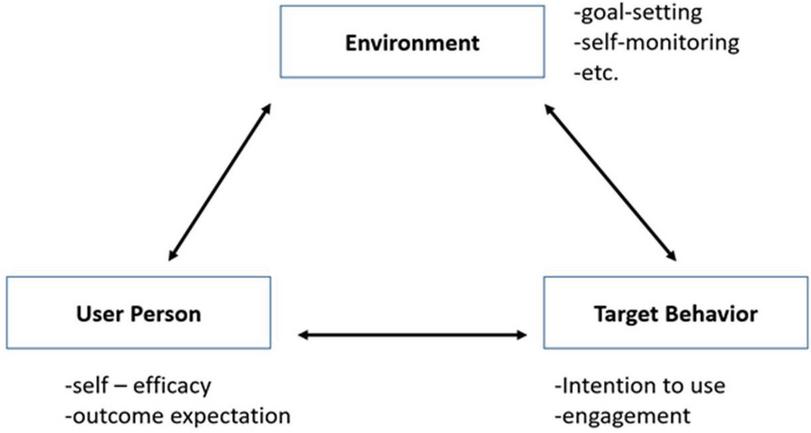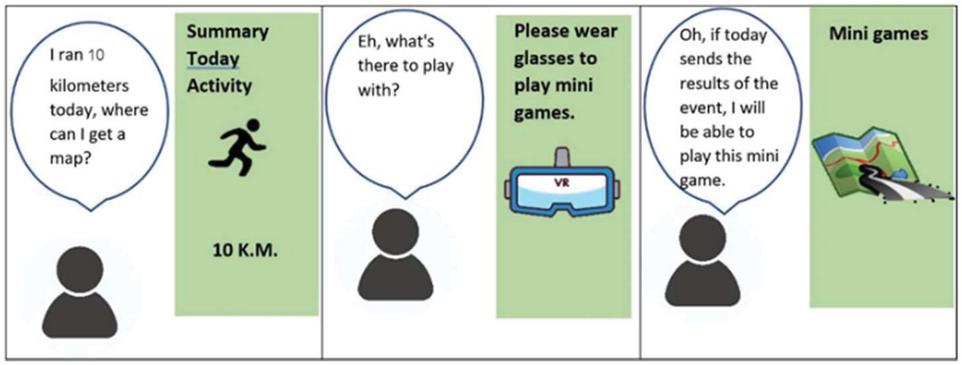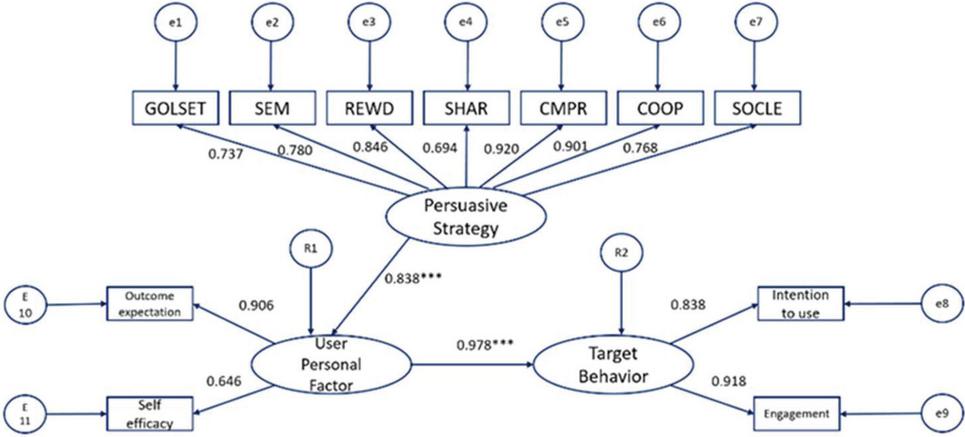A Conceptual Model of Personalized Virtual Reality Trail Running Gamification Design
Raslapat Suteeca, Smitti Darakorn Na Ayuthaya and Supaporn Kiattisin*
Technology of Information System Management Division, Faculty of Engineering, Mahidol University, Thailand
E-mail: raslapat.s@cmu.ac.th; smitti.dar@mahidol.ac.th; supaporn.kit@mahidol.ac.th
*Corresponding Author
Received 24 February 2022; Accepted 25 September 2022; Publication 29 April 2023
Abstract
Individuals’ running styles define trail running. Diverse motivational strategies for running emerge because of diverse running behaviors. Customizable design for motivation: when it comes to environmental considerations during a product’s or service’s use stage, the design process has become increasingly focused on behavior. Virtual reality enables the creation and integration of a variety of environments, as well as the redesign, retesting, and enhancement of these environments within a virtual computing structure. These benefits exist because players’ perspectives and behaviors in virtual environments are more comparable to those in their physical environments. The purpose of this study is to create a model for the relationship between persuasive strategy, user personal factors and target behavior that is effective based on the Social Cognitive Model, two hypotheses are tested using structural equation modelling (SEM). According to the findings, persuasive strategies have a significant positive influence on user personal factors. Second, user personal factors were able to influence target behaviors. To increase intrinsic motivation, virtual reality application designers should support persuasive tactics such as goal setting and self-monitoring in a target context. These results may guide designers in selecting effective persuasion strategies for various user groups.
Keywords: Persuasive strategy, target behavior, user personal factors, social cognitive model, gamification, structure equation modelling (SEM).
1 Introduction
For decades, the study of gamification has been increasing in volume across a variety of fields, owing to technological advancement. This piques the researcher’s interest in applying his or her knowledge of Human Computer Interaction (HCI), which includes techniques from non-gaming or professional context video games. It is used to improve the user’s performance or business growth on the basis of a motivational concept, enjoyment, engagement, commitment, attractiveness, and emotion [1, 2]. It has also been applied extensively in education, medicine, marketing, business development, and sports [3–6].
Gamification is critical because it expresses the user’s desire to develop the commonly used pattern. However, research has been conducted on the use of persuasive strategies in the design of gamification to motivate many people. Oinas-Kukkonen [6] defined a “behavior change support system” as “a socio-technical information system with psychological and behavioral outcomes that is intended to form, alter, or reinforce attitudes, behaviors, or an act of compliance without resorting to coercion or deception.”
Applying AI technology to the study of individual behavior can enable players to understand patterns and present a more personalized approach to learning or long-term use. This is similar with research by Klaus and Maklan [14], who discovered that students interested in mountain biking or skiing choose areas conducive to their hobby. When you think that the place where playing sports is not suitable for you will feel uncomfortable and don’t want to continue playing like that. The Gamification design model has applied psychology to both the theory of learning and internal and external motivation. To create a need to play or learn to meet the goals set. Such as using coins (Badges), collecting points (Points), leading the board. However, techniques have been studied in which patterns of people’s characteristics, feelings, behaviors and actions have been studied. It combines big data with elements of psychology to give players a better gamification experience. The gamification design process provides a path. fixing the situation and passing or levels, responses, rewards and learning techniques. Including the use of society to drive through social media, groups or communities and analytics through big data.
Creating an effective virtual learning environment is relatively straightforward. A process in which visitors, or other viewers, are hosted in a pre-designed environment. Additionally, developers can create a virtual reality environment that serves as a more advanced simulation for that activity. Wonder and imagination (as manifested in gaming applications), the potential complexity of virtual reality, and the powerful and unrealized benefits associated with these the environment is fostering the development of a new field known as design-science-research [7]. Virtual reality enables the creation and integration of a variety of environments, as well as the redesign, retesting, and enhancement of these environments within a virtual computing structure [8].
Virtual reality overcomes these constraints and offers a few benefits over traditional video offerings. While the subject is closely monitored, environments, volunteers, and simulated adversaries can interact and may at any time alter the nature of the information in which the player is immersed. Second, virtual reality enables researchers to control and optimize, in a systematic manner, all factors influencing player decisions to ensure reproducibility across the entire experiment. Ecological authentication could be a result of this adjustment to player behavior in real time. Thirdly, researchers can update the player’s view in a real-time virtual environment by tracking the player’s real-time head movements, enhancing the player’s sense of presence. With these advantages in virtual environments, players’ perspectives and behaviors are more akin to those in their physical surroundings in-the-moment perspective and behavior in real-world situations [5].
According to users’ individual preferences, persuasive theory, and the advancement of HCI, the researchers aim to design gamification through virtual reality (VR) technology. The benefits are to represent the running courses and create motivation.
2 Materials and Methods
2.1 A Conceptual Framework
This study focuses on personalized virtual reality trail running gamification design by using the motivation principle of persuasive strategy. Emerging technology is accepted to enhance the experience. The gamification system can be designed as follows: As mentioned previously, this design imports two inputs: The API data from exercise applications is used to retrieve the user’s most recent running distance and route map. Additionally, the second section makes use of personal identification information from a user’s social media profile. This method requires users’ permission to access personal information, after which the sections of behavioral selection, segments, and activity (running) duration are analyzed and determined to be the most appropriate trail running route for each user. The persuasive strategy is expected to deliver the individual component during this step. By presenting a users’ module that collects personal data, access histories/user records, and activity styles. The activities are classified into three categories: locations, route segments, and running distances. The locations, route segments, and running distance data are derived from the Context module. In summary, the motivation application is part of the persuasive module, which focuses on the user’s behavioral module based on accumulative distance from recent activities. The continuous process would collect and analyze data and then provide feedback on the best route. The running behavior is considered in greater detail. The data and all modules are demonstrated using virtual reality, which enables users to experience the real route, sounds, and the atmosphere of realistic running routes in 360 degrees.
The first step in developing a gamified virtual reality trial running design is to determine what factors contribute to motivation. In this study, we used Bandura’s social cognitive model.
2.2 Hypothesis
2.2.1 Persuasive strategies and the user personal factors
Researchers have applied Bandura’s [9] social cognitive model of reciprocal to determine the persuasive technology environment [10, 11]. The model illustrates how personal factors, environmental factors, and target behavior all interact to shape behavior in a reciprocal fashion. Social cognitive elements such as self-efficacy and outcome expectation are included in the personal components [10]. Both personal persuasive strategies (goal setting, self-monitoring, and so on) and social persuasive strategies are examples of persuasive strategies that integrate environmental factors. The Social Cognitive Model as shown in the Figure 1.
H1: persuasive strategies have positive influence on user personal factors
2.2.2 User personal factors and target behaviors
Refer to Bandura [12], who regulates human behavior. According to him, self-efficacy and outcome expectations are the two fundamental cognitive processes that control human action. Outcome expectations refer to the perceived outcomes of one’s conduct, while self-efficacy refers to one’s belief in one’s capacity to do an activity [13]. Self-efficacy refers to an individual’s belief in their ability to exert control over an important aspect of their own functioning. Motivation requires a strong component of self-related cognition. Self-efficacy influences decision-making. Self-efficacy can either stimulate or stifle motivation, and it is also linked to behavior [14].
H2: user personal factors have positive influence to target behavior.
Figure 1 Social cognitive theory.
2.3 Development of Initial Instrument
Design of a persuasive strategy concept for enhancing individualized virtual reality trail running. The creation of user motivation is based on a review of the literature. Oinas-Kukkonen and Harujumaa [22] classify persuasive strategy design into three groups and 28 strategies. Rather than that, the researchers considered and discovered a novel method of persuasion: goal setting [13, 15–19]. The researchers compiled 47 studies on exercise gamification design and reduced them to 29 to 7 significant factors, as shown in Table 1. The researchers developed the study steps in consultation with Li-Hsing Shih and Yi-cin Jheng [17], as well as Kiemute Oyibo and Julita Vassileva [16].
Step 1: Utilize virtual reality technology to conduct research into the factors that motivate users to participate in trail running. By emphasizing the importance of exercise, specifically running, as this study mentions, six case studies demonstrate how demographic data must be gathered using user attributes, a data-driven approach that considers a variety of possible demographics such as education level, occupation, monthly income, gender, and age.
Step 2: Identifying potential persuasive strategy candidates through a review of pertinent definitions and the definition of a variable as follows; utilizing the gamification design framework proposed by Li-Hsing Shih & Yi-Cin Jheng [17], the first of which is defining the system’s associated persuasive strategy. Persuasive strategies are defined in Table 1.
Table 1 Persuasive strategy definition for personalized virtual reality trail running gamification
| No. | Persuasive Strategy | Definition |
| PS 1 | Goal – setting (GOLSET) | A strategy for persuading users to make specific commitments to achieve a goal. |
| PS2 | Self-monitoring (SEM) | A persuasive strategy that enables users to monitor their individual performance or status aid users in accomplishing their objectives. |
| PS3 | Rewards (REWD) | A persuasive strategy that enables the awarding of incentives upon achievement of a goal. |
| PS4 | Sharing (SHAR) | A persuasive strategy that incentivizes users to share their social media experiences. |
| PS5 | Social comparison (CMPR) | A persuasive strategy that enables users to assess and compare their own performance and accomplishments to those of their peers. |
| PS6 | Cooperation (COOP) | A persuasive strategy that motivates users to collaborate to achieve a common goal and to be rewarded for their efforts. |
| PS7 | Social learning (SOCLE) | A persuasive strategy that users can learn and answer questions through groups or social media. |
Step 3: Describe the object accurately. The correct subject matter can be determined by determining the Index of Item Objective Congruence, or IOC, which will be examined by a human computer interaction (HCI) expert, a game developer, and a trail runner. The accurate description will be gathered and statistically analyzed to determine which questions or choices will be used to develop the investigation, with each question receiving an additional point. If the question is certain and directly related to the objective, mark it as 0. If an expert is unsure whether a question follows its objective or not, he or she should mark it as 1. If it is determined that a question does not adhere to its objective, the score will be calculated to determine the IOC. The question with an IOC of 0.50–1.00 is accurate, while the one with an IOC of less than 0.50 requires improvement.
Step 4: Create an example of a storyboard to collect the responses from the possible demographic users. Each storyboard contains three blocks that describe a series of hypothetical situations involving interaction between users and the persuasively built information system. Figure 2 illustrates a main objective persuasion method. The primary objective of a storyboard presentation is to involve respondents in the setting depicted in the storyboard for them to readily understand how the interaction would work in the system. Each storyboard contains three questions that assess respondents’ perceptions of the persuasiveness of various persuasive strategies. Each question is answered on a Likert scale ranging from 1 to 5.
Figure 2 Storyboard illustrating the reward of personalized trail running virtual reality gamification.
Three specialists with experience as professional trail runners, executive software developers, and UX/UI designers validated the questionnaire’s content and language validity. By ensuring that each questionnaire has an IOC value greater than 0.5 and by improving the questions in accordance with the recommendations, the criteria for evaluating all questionnaires in terms of their content or measurement purposes are appropriate for the research.
Two sample size determination criteria were developed using Hair’s [20] and Cochran’s [21] formulas. Based on these two criteria, the researcher assigned 400 runners who had run for at least six months to exercise application. This is a quantitative study that includes a survey. We conducted a descriptive test and an analysis of construct validity. To determine item validity and to discover and validate influential components, the researchers used exploratory factor analysis (EFA) and confirmatory factor analysis (CFA). The Chi-Square value (), the Goodness of Fit Index (GFI), the Tucker Lewis Index (TLI), the Normal Fit Index (NFI), the Comparative Fit Index (CFI), and the P-value were used to determine the model’s construct validity [22].
3 Results
3.1 Descriptive Statistic
A total of 400 runners who have incorporated gamification into their training treatment modalities were surveyed. To ensure effective responses, researchers tracked each respondent’s time was spent on each question and included an attention filter question in the questionnaire to assess whether respondents paid attention to each question. Following screening against the two criteria outlined previously, a total of 400 valid responses were retained.
3.2 Exploratory Factor Analysis and Confirm Factor Analysis
This section discusses our findings in detail, including the sample size and procedure, measures, exploratory factor analysis (EFA), confirmatory factor analysis (CFA), descriptive statistics, path analysis in structure equation modeling, and the concept of a circular model for virtual reality trail running gamification.
Table 2 CFA results for persuasive strategy principles, user personal factors and target behavior
| Variable | CFI | NFI | GFI | RASEA | TLI | P | |||
| (N 400) | df | (2) | (0.95) | (0.95) | (0.95) | (0.5) | (0.95) | (0.05) | |
| Persuasive strategy principles | 7 | 7.252 | 1.036 | 1.000 | 0.997 | 0.995 | 0.10 | 1.000 | 0.403 |
| User personal factors | 2 | 1.796 | 0.989 | 1.000 | 0.998 | 0.998 | 0.000 | 1.001 | 0.407 |
| Target behavior | 4 | 6.534 | 1.633 | 0.998 | 0.995 | 0.993 | 0.040 | 0.995 | 0.163 |
The EFA, Kaiser-Meryer-Olkin (KMO), and Barlett tests were used to determine whether the data were appropriate for the EFA. The KMO coefficient was determined to be 0.948, and the Barlett test indicated that the value was significant (). The CFA output depicted in Table 2 depicts the fit indices for persuasive strategy principles, user personal factors and target behavior and were fit within the modified values as Browne suggested [23, 24].
Table 3 The result of reliability
| Reflective Scale (Measured on 1–5-point Likert Scale) | Standardized Factor Loading |
| Persuasive strategies | |
| (Cronbach’s alpha 0.829: CR 0.930: AVE 0.657) | |
| Goal – setting | 0.737 |
| Self – Monitoring | 0.780 |
| Sharing | 0.694 |
| Reward | 0.846 |
| Social Comparison | 0.920 |
| Cooperation | 0.901 |
| Social learning | 0.768 |
| User personal factors | |
| (Cronbach’s alpha 0.899: CR 0.760: AVE 0.619) | |
| Outcome expectation | 0.906 |
| Self – efficacy | 0.646 |
| Target behavior | |
| (Cronbach’s alpha 0.917: CR 0.871: AVE 0.772) | |
| Intention to use | 0.838 |
| Engagement | 0.918 |
Convergent validity (using the loading factor and the Average Variance Extracted (AVE)) as well as discriminant validity were used to test for validity in this study. If both the loading factor and the AVE score exceed 0.50, the instrument has a high degree of validity [25]. The loading factor and AVE score in Table 3 are both greater than 0.50, indicating that the constructed instrument has a high degree of validity. The AVE root and its correlation with other variables are compared to determine the validity of the validity discriminant. The AVE root square score must be greater than the correlation score of the variables. Table 3 details the discriminant variable test result. The AVE root square score is greater than the correlation coefficients of the variables, indicating that the instrument is valid.
The reliability of this study was determined using Cronbach’s alpha and composited reliability. When the Cronbach alpha value is greater than 0.70 [26] and the composite reliability score is greater than 0.70, the instrument is regarded as reliable [25]. The reliability test results are summarized in Table 3. The Cronbach alpha and composite reliability ratings are greater than the minimum requirements, it is possible to conclude that the instrument produced is reliable.
3.3 Structural Model Analysis
Through modeling, structural equations demonstrate the relationship between a construct (latent) and a variable. By specifying the specification of a model by using structural equation modeling, we were able to confirm all the hypotheses. As previously stated, H1 indicates that persuasive strategies have a positive effect on user personal factors, while H2 indicates that user personal factors have a positive effect on target behaviors. In Figure 3, the SEM for the research model was calculated.
Figure 3 SEM full model result.
The term “goodness of fit” refers to a metric that is used to determine the degree to which observed data matches the anticipated model (assumption). The agreed-upon level of fit must be greater than the agreed-upon score. This is the criterion for obtaining a goodness of fit score: The p-value is 0.304 (a value greater than 0.05 is recommended by [27], and the CMIN/DF ratio is 1.123. (Ghozali, [28] recommends a value of 2). As a result, the fit of the model is satisfactory. CFI (recommendation value greater than 0.90, [29]), GFI 0.987 (recommendation value greater than 0.90, [29]), NFI 0.992 (recommendation value greater than 0.90, [29]) IFI 0.999 (recommendation value greater than 0.90, [30]) TLI 0.998 (recommendation value greater than 0.90, [29]), RMSEA = 0.18. A result, the fit of the model is satisfactory.
All hypotheses in this study are accepted (H1-H2). The results of the hypothesis test are as follows: First, persuasive strategies have a positive influence on user personal factors (; ). Second, user personal factors have a positive influence on target behaviors (; ). Table 4 explains the result of the hypothesis test.
Table 4 Hypothesis test result
| Level | Hypothesis | Result | Explanation |
| 1 | Persuasive strategies user personal factors | H1 accepted | |
| 2 | User personal factors target behavior | H2 accepted | |
| 0.001. |
3.4 Mapping Game Design
Following the selection of candidate factors, the next step is to identify the game design elements that will aid in achieving a high level of persuasion when combined with the variable chosen. To relate game design features to candidate factors, an individual’s behavior was developed. Prior to creating the affinity diagram, the Mechanic, Dynamics and Aesthetics: MDA framework was used to analyze various elements of well-known gamification websites [31]. Condensing the collected game materials into a reasonable number of functional game design pieces utilizing the affinity diagram method is crucial, as is being persuasive when convincing players to adopt trail running virtual reality gamification. The following three-step procedure outlines how game design elements were selected for this study:
1. Techniques of gamification, seven gamification techniques were listed by Xu [32], some gamification techniques were culled from well-known gamification websites, Manrique [33] included a toolkit of 35 gamification techniques.
2. When classified using the MDA framework, 72 gamification techniques were assigned to the category of game mechanics, 77 to the category of game dynamics, 29 to the category of game aesthetics, and 9 to the category of not classified at all. After excluding nine non-MDA-compliant gamification techniques and those relating to game aesthetics, which merely describe how users would react and feel about the game.
3. At this point, three domain experts were presented with the 30 game design elements listed above for additional review. As a result, twelve game mechanics and dynamics were removed or consolidated. A total of 24 game design elements were used to create an affinity diagram. Table 5 summarizes the 24 game design elements in total.
Table 5 24 game design elements for the creation of affinity diagrams
| Game Mechanic | Game Dynamic |
| Modifiers | Punishment |
| Leaderboard | Progression dynamic |
| Tasks | Appointment dynamics |
| User profile | Combos |
| Activity feed | PvP (player vs player) |
| Quizzes | Shell game |
| Teams | Boss battles |
| Easter eggs | Free lunch |
| Voting/Voice | |
| Reward schedules | |
| Tutorials | |
| Lottery | |
| Virtual trade | |
| Gifting and sharing | |
| Voting/Voice | |
| Collection |
To map 24 game design elements to candidate factors, we used the affinity diagram method proposed by Jonasson [17], This categorizes 24 game design components.
Step 1: Invited 25 experts in user experience/user interface design and game development from academia and industry to share their perspectives.
Step 2: Determine the objective. The purpose of this article is to assist designers in implementing the concept of gamification in conjunction with a strategy and the principles for gamifying a trial running virtual reality design. What we’re interested in is the relationship between the application of each game design aspect to each persuasive strategy.
Step 3: Select from several different game design features and potential factors. The purpose, the data gathered.
4 Discussion
This study discovered that a path model of persuasive strategies had a significant effect on both target behavior and user personal behavior. This is a high value in the SEM, indicating that the model adequately fits the empirical data. Persuasive strategies had a significant positive effect on users’ personal behaviors. According to social cognitive theory-based research, perceived self-efficacy and outcome expectations are significant predictors of physical activity behavior.
This study discovered that by focusing on competition or chasing between players or groups, the need for exercise can be stimulated. In which case, players must upload their running results to the application, which will analyze their running behavior and routes to present the optimal route. Additionally, the design of the avatar in virtual reality motivates players when they are compiling data or measuring distances. Along with receiving new routes, player will also receive a costume and badges to earn for completing various physical activities or special occasions. Individuals, on the other hand, can set goals based on their performance and carry out missions assigned to them. It will instill pride in players and motivate them to work toward the next goal.
Similarly, Elder et al. [34] discovered that social learning theory implies that perceptions of abilities and reinforcement may have a more direct effect on behavior. Previously published research [24] established that potential impact is a strong motivator of behavior change through four strategies: social comparison, cooperation, reward, and social learning. In the domain of behavior theory, personal factors such as social per-suasive strategies are the strongest predictors of behavior change for individuals’ cultures. Goal setting and self-monitoring are the strongest predictors of users’ desire to utilize a fitness app to inspire behavior change in the application domain. Apart from target behavior, the effectiveness of target behavior is influenced by the user’s personal characteristics (outcome expectations and self-efficacy). Oyiba and Vassileva [22] advocated in favor of using social methods that emphasize competition and teamwork to encourage target audiences to engage in physical exercise. Completion can be accomplished through the use of a leaderboard, or cooperation can be accomplished by allowing users to work in teams of two or more to accomplish a common goal and share the accompanying prizes.
Oyibo et al. [15] summarized this path to exercise training by stating that the physical environment directly influences self-efficacy, which in turn influences outcome expectations, which in turn influences physical activity. The researchers summarized the path to physical activity engagement, from the physical environment to individual fac-tors that influence physical activity. Each determinant is associated with one or more persuasive strategies in this application. Individual running behavior patterns vary according to performance level, which means that performance and training styles also vary. As a result, using the results of each training session or run, exercisers analyze and predict the running route, which will be presented in VR format. The running route is unique in terms of location and slope, and players can take a 360-degree look at it. However, players will have a more enjoyable and challenging experience if they have access to a social support system, such as forming a team to open the map together and sharing experiences from similar or divergent paths. Additionally, team competition and the ability to earn badges or special rewards via the team system encourage players to keep track of their own and their teammates’ progress.
Most persuasive tactics in the area of behavior theory are founded on Fogg’s [35] persuasive design principles, Oinas-Kukkonen and Harjumaa’s [20] persuasive system design model, and Orji and Mandryk’s [16] design recommendations for healthy eating behavior. The researchers discovered that social support (together with self-efficacy)—which are related with social qualities such as competition, cooperation, and so on—was a major predictor of physical activity behavior among persons living in an individualist culture.
5 Conclusion
The article presents the findings of an empirical study involving 400 participants who have used exercise activity applications and expressed an interest in integrating personalization and virtual reality trail running gamification into seven persuasive strategies: goal setting, self-monitoring, reward, social comparison, cooperation, social learning, and sharing. In general, all seven strategies were deemed persuasive by participants. The findings indicate that when used persuasively, each of the strategies has the potential to motivate behavioral change. Social persuasive strategies, such as social comparison, cooperation, reward, and social learning, were found to be the most per-suasive, whereas personal persuasive strategies, such as goal setting and self-monitoring, were found to be the least persuasive. Additionally, we discovered that, more than any other factor, outcome expectation motivates users to use the ap-plication. This may be an extremely effective method of indicating the target, highlighting the critical nature of tailoring persuasive strategies to maximize their effectiveness. To summarize, our findings can aid designers in determining the most effective strategies to use when developing persuasive virtual reality trail running applications.
References
[1] D. Arigo, M. M. Brown, K. Pasko, and J. Suls. 2020. Social comparison features in physical activity promotion apps: scoping meta-review J. medical Internet research, vol. 22, no. 3, p. e15642
[2] D. Cho and H. Kim. 2020. The influence of visual design class using gamification on the learning motivation and academic achievement of first-year high school learners, Archives of Design Research, vol. 33, no. 2, pp. 215–228.
[3] K. Al-Kodmany. 2002. Visualization tools and methods in community planning: from freehand sketches to virtual reality. J. planning Literature, vol. 17, no. 2, pp. 189–211.
[4] R. Bartle 1996. Hearts, clubs, diamonds, spades: Players who suit MUDs, J. MUD research, vol. 1, no. 1, p. 19.
[5] B. Buxton. 2010. Sketching user experiences: getting the design right and the right design. Morgan kaufmann,
[6] W. W. Chin, B. L. Marcolin, and P. R. Newsted. 2003. A partial least squares latent variable modeling approach for measuring interaction effects: Results from a Monte Carlo simulation study and an electronic-mail emotion/adoption study, Information systems research, vol. 14, no. 2, pp. 189–217.
[7] A. Schmeil, M. J. Eppler, and S. de Freitas. 2012. A structured approach for designing collaboration experiences for virtual worlds, J. Association for Information Systems, vol. 13, no. 10, p. 2.
[8] V. Liagkou, D. Salmas, and C. Stylios. 2019. Realizing virtual reality learning environment for industry 4.0, Procedia CIRP, vol. 79, pp. 712–717.
[9] K. D. Carillo. 2010. Social cognitive theory in is research–literature review, criticism, and research agenda, in International Conference on Information systems, Technology and management,: Springer, pp. 20–31.
[10] R. Orji and K. Moffatt. 2018. Persuasive technology for health and wellness: State-of-the-art and emerging trends, Health informatics journal, vol. 24, no. 1, pp. 66–91.
[11] R. Orji and R. L. Mandryk. 2014. Developing culturally relevant design guidelines for encouraging healthy eating behavior, International Journal of Human-Computer Studies, vol. 72, no. 2, pp. 207–223.
[12] A. Bandura. 1998. Health promotion from the perspective of social cognitive theory, Psychology and health, vol. 13, no. 4, pp. 623–649.
[13] K. Oyibo, I. Adaji, R. Orji, B. Olabenjo, M. Azizi, and J. Vassileva. 2018. Perceived persuasive effect of behavior model design in fitness apps, in Proceedings of the 26th Conference on User Modeling, Adaptation and Personalization, pp. 219–228.
[14] M. Conner and P. Norman. 2015. EBOOK: Predicting and Changing Health Behaviour: Research and Practice with Social Cognition Models. McGraw-Hill Education (UK).
[15] R. Orji. 2016. Persuasion and Culture: Individualism-Collectivism and Susceptibility to Influence Strategies, in PPT@ PERSUASIVE, pp. 30–39.
[16] K. Oyibo and J. Vassileva. 2020. Persuasive Features that Drive the Adoption of a Fitness Application and the Moderating Effect of Age and Gender, Multimodal Technologies and Interaction, vol. 4, no. 2, p. 17.
[17] L.-H. Shih and Y.-C. Jheng. 2017. Selecting persuasive strategies and game design elements for encouraging energy saving behavior, Sustainability, vol. 9, no. 7, p. 1281.
[18] R. Orji, L. E. Nacke, and C. Di Marco. 2017. Towards personality-driven persuasive health games and gamified systems, in Proceedings of the 2017 CHI Conference on Human Factors in Computing Systems, pp. 1015–1027.
[19] C. Groening and C. Binnewies. 2019. Achievement unlocked!-The impact of digital achievements as a gamification element on motivation and performance, Computers in Human Behavior, vol. 97, pp. 151–166.
[20] J. F. Hair, 2009. “Multivariate data analysis.”
[21] W. G. Cochran. 2007. Sampling techniques. John Wiley & Sons.
[22] R. E. Schumacker and R. G. Lomax. 2004. A beginner’s guide to structural equation modeling. psychology press.
[23] M. W. Browne and R. Cudeck. 1992. Alternative ways of assessing model fit, Sociological methods & research, vol. 21, no. 2, pp. 230–258.
[24] J. F. Hair Jr, “Multivariate Data Analysis Joseph F. Hair Jr. William C. Black Barry J. Babin Rolph E. Anderson Seventh Edition.”
[25] J. Hair, W. Black, B. Babin, R. Anderson, and R. Tatham. 2010. Multivariate data analysis upper saddle river: pearson prentice hall, Links.
[26] U. Sekaran and R. Bougie. 2016. Research methods for business: A skill building approach. John Wiley & Sons.
[27] R. H. Hoyle. 1995. Structural equation modeling: Concepts, issues, and applications. Sage.
[28] C. P. Tirtiana. 2013. Pengaruh kreativitas belajar, penggunaan media pembelajaran power point, dan lingkungan keluarga terhadap hasil belajar mata pelajaran akuntansi pada siswa kelas X AKT SMK Negeri 2 Blora tahun ajaran 2012/2013 (motivasi belajar sebagai variabel intervening), Economic Education Analysis Journal, vol. 2, no. 2, pp. 15–23.
[29] B. M. Byrne. 2013.Structural equation modeling with EQS: Basic concepts, applications, and programming. Routledge.
[30] L.-T. Hu and P. M. Bentler. 1995. “Evaluating model fit,”
[31] H. Robin, L. Marc, and Z. Robert. 2004. A Formal Approach to Game Design and Game Research, GDC. San Jose.
[32] Y. Xu. 2011. Literature review on web application gamification and analytics, Honolulu, HI, pp. 11-05.
[33] V. Manrique, Inspiring Game Examples for Gamification Mechanics, Epic Win Blog.
Biographies

Raslapat Suteeca received the B.Sc. degree in education technology from Srinakarinwirot University, Thailand in 2001. He received the M. Edu. degree in development psychology from Srinakarinwirot University in 2004. She is currently Ph.D. student in Technology of Information System Management. Her areas of research interests are Information Technology Management, Multimedia and Programming for digital business.

Smitti Darakorn Na Ayuthaya received the B.Econ. degree in applied business administrator from University of the Thai Chamber of Commerce, Bangkok, Thailand, in 1981, the M.B.A. degree in marketing, Colorado university, United States of America in 1985, the M.B.A. degree in innovation management from Ramkhamhaeng university, Bangkok, Thailand, the Ph.D. degree in Public Administration from University of Northern Philippines, Philippines, in 2010, and the Ph.D. degree in business administration, Lyceum of Philippines in 2020 and 2006. He is currently the program director of Master of Science program in information technology management, Faculty of engineering, Mahidol University, Thailand. He is a member of broad of the Zoological Park organization of Thailand Acting Director of the Zoological Park Organization of Thailand.

Supaporn Kiattisin received the B.Eng. degree in applied computer engineering from the Chiang Mai University, Chiang Mai, Thailand, in 1995, the M.Eng. degree in electrical engineering and the Ph.D. degree in electrical and computer engineering form King Mongkut’s University of Technology Thonburi, Bangkok, Thailand, in 1998, and 2006. She is currently the program director of Technology of Information System Management Division, Faculty of Engineering, Mahidol University, Thailand. Her researches interests include computer vision, image processing, robot vision, signal processing, pattern recognition, artificial intelligence, IoT, IT management, digital technologies, big data and enterprise architecture with TOGAF 9 certified. She is a member of IEICE and TESA. She served as a Head of IEEE Thailand Chapter in Bio Medical Engineering. She also served as the Chairman of the TimesSOC Transaction Thailand. Enterprise Architecture (EA), data sciences, information technology in E-government and digital economy (DE).
Journal of Mobile Multimedia, Vol. 19_4, 1049–1066.
doi: 10.13052/jmm1550-4646.1947
© 2023 River Publishers





